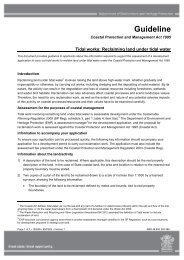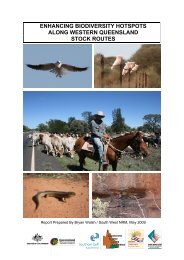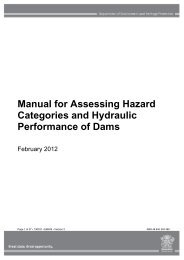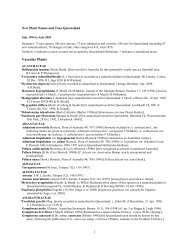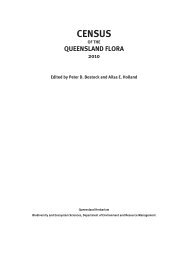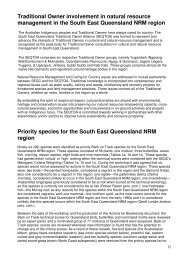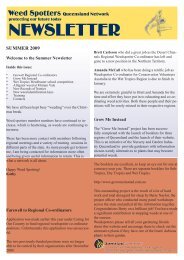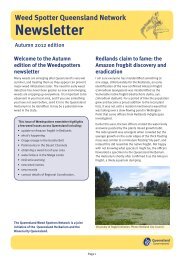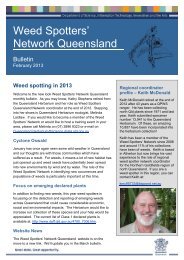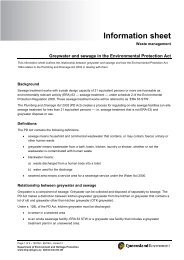Distribution, abundance and biology of Group V humpback whales ...
Distribution, abundance and biology of Group V humpback whales ...
Distribution, abundance and biology of Group V humpback whales ...
You also want an ePaper? Increase the reach of your titles
YUMPU automatically turns print PDFs into web optimized ePapers that Google loves.
Figure 1. Queensl<strong>and</strong> marine parks <strong>and</strong> other areas <strong>of</strong> importance for <strong>humpback</strong>s<br />
2.3 International status<br />
The <strong>humpback</strong> is protected throughout the New Zeal<strong>and</strong><br />
Exclusive Economic Zone under several pieces <strong>of</strong> legislation<br />
the Marine Mammals Protection Act 1978 (MMPA);<br />
the Marine Mammals Protection Regulations 1992; the<br />
Treaty <strong>of</strong> Waitangi Act 1978; <strong>and</strong> the Fisheries Act 1996.<br />
The International Union Conservation <strong>of</strong> Nature specialist<br />
<strong>Group</strong> (IUCN) listed the <strong>humpback</strong> as vulnerable to<br />
extinction, due to the observed population reduction <strong>of</strong> more<br />
than 20 percent in the last three generations, due principally<br />
to previous commercial whaling activities (IUCN 1996).<br />
Other international organisations responsible for the<br />
conservation <strong>of</strong> the <strong>humpback</strong> include The Convention on<br />
the International Trade <strong>of</strong> Endangered Species (CITES),<br />
the Convention for Migratory Species (Bonn Convention)<br />
<strong>and</strong> the International Whaling Commission (IWC).<br />
3.Classifi cation <strong>and</strong> description<br />
3.1 Taxonomic classifi cation<br />
The extant members <strong>of</strong> the Order Cetacea are divided into<br />
two sub-orders toothed <strong>whales</strong> (Odontoceti) <strong>and</strong> baleen<br />
<strong>whales</strong> (Mysticeti) to which <strong>humpback</strong> <strong>whales</strong> belong<br />
(Figure 2). Baleen <strong>whales</strong> possess plates <strong>of</strong> hair like<br />
structures used to sieve prey from water taken in whilst<br />
slowly swimming <strong>and</strong> have a paired blowhole on top <strong>of</strong><br />
head. Species are found in all oceans <strong>of</strong> the world usually<br />
in high latitudes <strong>and</strong> most species migrate between summer<br />
feeding <strong>and</strong> winter areas.<br />
Baleen <strong>whales</strong> are divided into the following four<br />
families, all <strong>of</strong> which have living members, right <strong>whales</strong><br />
(Balaenidae), pygmy right whale (Neobalaenidae), gray<br />
<strong>whales</strong> (Eschrichtidae), <strong>and</strong> rorquals (Balaenopteridae).<br />
The rorquals, to which <strong>humpback</strong> <strong>whales</strong> belong, have up<br />
to 100 throat grooves or pleats that extend from underneath<br />
the lower jaw to behind the fl ippers in all members <strong>of</strong> the<br />
family. The <strong>humpback</strong> whale has between 12 <strong>and</strong> 36 throat<br />
grooves that exp<strong>and</strong> whilst feeding but are otherwise<br />
rarely seen.<br />
The <strong>humpback</strong> is classifi ed as part <strong>of</strong> the Order Cetacea,<br />
sub-order baleen <strong>whales</strong> (Mysticeti) <strong>and</strong> Family rorquals<br />
(Balaenopteridae). The <strong>humpback</strong> long went under the<br />
name Megaptera nodosa Bonnaterre, 1789, but Kellogg<br />
(1932) showed that Borowski’s name has priority<br />
(Rice 1998). The <strong>humpback</strong> was placed in its own genus<br />
to emphasise its discrete morphology. There are no<br />
taxonomically valid subgroups currently recognised but<br />
there are several separate populations described based<br />
on the species geographical wintering <strong>and</strong>/or feeding<br />
separations (ANCA 1996).<br />
3 • <strong>Distribution</strong>, <strong>abundance</strong> <strong>and</strong> <strong>biology</strong> <strong>of</strong> <strong>Group</strong> V <strong>humpback</strong> <strong>whales</strong> Megaptera novaeangliae: A review • August 2002



